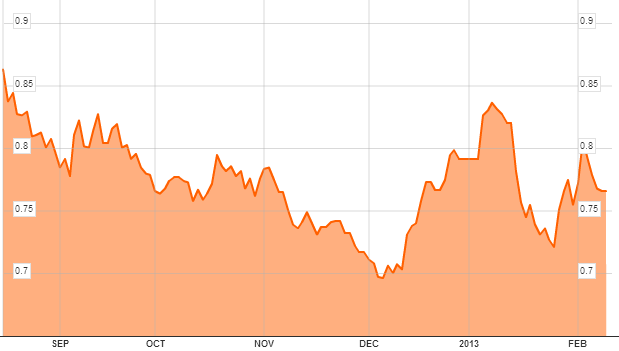London Gold Market Report
from Ben Traynor
BullionVault
Tuesday 19 February 2013, 07:00 EST
WHOLESALE prices for gold bullion hovered above $1610 an ounce during Tuesday morning’s London session, having ticked higher in Asian trading following losses yesterday, as stock markets also gained, with the US set to reopen following a holiday yesterday.
Gold is still down around 3% on the month however following last week’s drop.
“[Last week’s] bearish close should lead to a sell-off to below the $1600 level unfolding in the weeks to come,” reckons Axel Rudolph, senior technical analyst at Commerzbank.
“Gold broke the support line since May [last week],” adds a note from technical analysts at Societe Generale, “and the key support region of $1630 which was composed of last summer’s congestion…it is therefore set to correct lower.”
Silver meantime held just above $30 an ounce throughout this morning, around 4% down on the month, as commodities and US treasury bond prices were also little changed on the day.
Sales of silver American Eagle coins by the US Mint so far this month have already beaten the total for the whole of last February. Gold American Eagle sales for this month meantime are more than double those of the whole of February 2012.
Over in India, the world’s biggest gold buying nation, dealers reported light demand for gold Tuesday, as the Rupee failed to recover last week’s losses against the Dollar.
Last Friday, the Securities and Exchange Board of India (Sebi) announced that gold exchange traded funds can now invest up to 20% of their assets in gold deposit schemes run by banks, on which the banks would pay them a rate of return.
“Gold certificates issued by banks in respect of investments made by gold ETFs in [Gold Deposit Schemes] shall be held by the mutual funds only in dematerialized form,” said a statement from Sebi.
Encouraging people to invest in ‘dematerialized’ gold rather than own bullion itself is one of the strategies discussed in a Reserve Bank of India report published earlier this month, which looks at ways of reducing the amount of gold India imports.
Over in Vietnam, owners of small amounts of gold could be forced to sell their metal at a discount following a recent decree by that country’s central bank, according to local press reports Tuesday.
The State Bank of Vietnam has said only one tael (approx. 1.2 troy ounces) bars produced by the Saigon Jewelry Co. can be bought and sold. In 2011, the SBV announced it had “administratively acquired” SJC. The SBV later announced SJC as the producer of the national gold brand, while also drafting rules on eligibility that excluded many competitors.
In Tehran meantime, a spokesman for Iran’s foreign ministry has criticized proposals to ease sanctions on dealing in gold with Iran in return for the country shutting down its Fordow nuclear plant, Reuters reports.
“Lately they have said ‘Shut down Fordow, stop enrichment [of uranium], and we will allow gold transactions’,” Ramin Mehmanparast said Monday.
“They want to take away the rights of a nation in exchange for allowing trade in gold.”
Last year saw Iran become the number one destination for Turkish gold exports, in what came to be dubbed a “gold-for-gas” trade. Bullion dealers elsewhere in the Middle East however have begun to avoid gold bars produced in Turkey amid fears that dealing such bars may be part of efforts to get round US sanctions.
Earlier this month, Turkey’s economy minister said his country “is not bound by restrictions imposed by others”
Here in Europe, economic sentiment has improved in both Germany and the Eurozone as a whole this month, according to ZEW survey data published this morning.
“We enter 2013 in a more stable financial environment than in recent years,” European Central Bank president Mario Draghi told the European Parliament yesterday.
Draghi added that recent talk of currency wars is “really excessive”.
“Most of the exchange rate movements that we have seen were not explicitly targeted, they were the result of domestic macroeconomic policies meant to boost the economy,” he said.
Gold value calculator | Buy gold online at live prices
Editor of Gold News, the analysis and investment research site from world-leading gold ownership service BullionVault, Ben Traynor was formerly editor of the Fleet Street Letter, the UK’s longest-running investment letter. A Cambridge economics graduate, he is a professional writer and editor with a specialist interest in monetary economics. Ben can be found on Google+
(c) BullionVault 2013
Please Note: This article is to inform your thinking, not lead it. Only you can decide the best place for your money, and any decision you make will put your money at risk. Information or data included here may have already been overtaken by events – and must be verified elsewhere – should you choose to act on it.
 Bakken ‘City’ – the Biggest New Place in the States” border=”0″>
Bakken ‘City’ – the Biggest New Place in the States” border=”0″>




